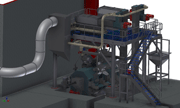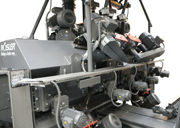E-Archive
Articles
in Vol. 13 - July Issue - Year 2012
A continuous shot blast machine that fully meets the customer’s capacity and space requirements. De-Scaling Of Steel Billets At A Constant Travel Speed Of 90 Meters Per Minute

The shot blast machine RKL 8-55/180 allows the de-scaling of billets with cross-sectional dimensions of max. 180 x 180 mm (7.1 x 7.1") at a speed of 90 meters per minute

The optimum wear protection and ease of maintenance of the overall shot blast system guarantee high equipment availability and process stability

The eight high-performance Long-Life turbines ϒ 520 with an installed power of 55 kW each are placed at an optimum angle of impact on the billets and are throwing about five metric tons (11,000 lbs) of media/minute

The quality standards call for an SA 2 degree of cleanliness of the billets after blast cleaning with the initial surface condition having a rust grade of "B"
Billets, usually shaped with a square profile, are produced in continuous casting lines or in hot rolling mills. At the end of the manufacturing process, stringent quality standards call for a surface cleanliness of minimum SA 2 for the final product. When Saarstahl AG had to replace its old shot blast system for the central surface preparation of semi-finished products, Rösler developed the easy-to-maintain RKL 8-55/180 shot blast system that fully meets the space requirements specified by the customer. Equipped with eight Long-Life high performance blast turbines and two blast media recycling systems, the RKL 8-55/180 achieves a de-scaling speed of 90 meters per minute.
With its Roheisengesellschaft Saar mbH and manufacturing locations in Neunkirchen, Burbach and Völklingen, Saarstahl AG is one of the world’s leading manufacturers of long steel products. The product portfolio includes wire rods, bar steel, semi-finished steel products in various qualities and open die steel forgings. These intermediate products are indispensable raw materials for various industries like automotive, civil engineering, energy, general machine building and aerospace. Saarstahl maintains its high quality standard by numerous quality tests during the manufacturing process.
A technical concept that meets stringent capacity requirements
As part of the overall quality procedure, the finished billets must undergo a surface cleanliness test. The specs for this test call for a surface that is free of rust and scale, and a cleanliness degree of SA 2 with the initial surface condition having a rust grade of "B". The cleaning of the surface, i.e. the removal of rust and scale, takes place by exposing the parts to a shot blasting process. To modernize this operation, Saarstahl in Neunkirchen invested in a new shot blast system for square billets with edge lengths of max. 180 x 180 mm (7.1 x 7.1 inches). The key requirements for this project were the specified high capacity, the adaptation of the shot blast machine to the available space of maximum 8,000 mm/315 inches (H) x 8,400 mm/330" (L) and an extremely short lead time. The project management at Saarstahl presented these requirements to the Rösler Oberflächentechnik GmbH.
With the RKL 8-55/180, the Rösler engineers developed a compact, high performance shot blast system which, despite a significantly increased capacity to 90 m/minute, required only minor modifications of the physical footprint. In addition, the Rösler proposal included various technical features that not only guaranteed the specified degree of surface cleanliness but also provided high process stability and equipment uptime as well as easy maintenance and excellent wear characteristics.
A blast media throughput of 5 metric tons per minute
The RKL 8-55/180 is equipped with eight Rösler Long-Life blast turbines, type ϒ 520, designed by Rutten and with an installed power of 55 kW each. A blast media throughput of five metric tons (11,000 lbs.) guarantees that the max. 180 x 180 mm (7.1 x 7.1") thick square billets are de-scaled in the Rösler RKL shot blast system within a cycle time of 20 seconds. The turbines are equipped with indirect belt drives. A special tensioning bracket ensures that the six V-belts driving one turbine have the same tension.
The high-performance blast turbines at Saarstahl are equipped with Gamma-Y throwing blades which are characterized by their dual operating surface. Since the key components of the Gamma turbines are manufactured from extremely wear-resistant high alloy steel, they offer an 8 to 16 x higher uptime than conventional blast turbines. Moreover, the curved throwing blades provide a highly "fluid" acceleration of the blast media. In comparison to conventional turbines, these curved blades in combination with an optimized media dosing system, produce 10% higher throwing speeds at the same RPM and more or less identical turbine diameters.
A design that covers the smallest technical details
The high performance turbines are arranged in a circular fashion around the blast chamber with its dimensions of 5,920 x 1,800 x 2,485 mm (L x B x H), equivalent to 233 x 71 x 98 inches (L x W x H). To keep the blast media interference caused by ricochet at a minimum, the optimum placement of the turbines was determined by a 3D simulation of the blast process. This guaranteed not only homogeneous blast media coverage but also an optimum angle of impact on the billet surface.
The billets travel through the blast machine on a heavy-duty roller conveyor. The five chain-driven rollers in the blast chamber are strategically placed to prevent their direct exposure to the blast stream. This prolongs their operating life significantly. Of course, considering this heavy-duty shot blast application, the blast chamber, made from manganese steel, is equipped with an optimum wear protection. Those areas in the blast chamber directly exposed to the blast stream are lined with easy-to-replace wear plates made from highly wear-resistant manganese steel. The entry and exit areas in the blast chamber contain media-collecting hoppers equipped with louvers for preventing media spillage. Additional media spillage hoppers equipped with fresh air vents and slide-in, louvered rubber curtains are placed outside of the blast chamber. They prevent the spillage of blast media into the immediate manufacturing environment.
Two blast media recycling systems save space and facilitate maintenance
The blast media thrown for blast cleaning the billets is collected in the bottom of the blast chamber from where an auger delivers the contaminated media to two augers placed at a 90-degree angle to the first auger. They transport the blast media to the two bucket elevators. At the top of the elevators, two augers deliver the media to the cleaning system consisting of screen drums and air wash separator. In a first step, the screening drums remove coarse particles like, for example, slag. Subsequently, the air wash separator removes dust and fine media particles from the blast media. In this respect, it is extremely important that the media curtain is evenly distributed over the complete width of the air wash separator. The cleaned blast media is then transferred to a media hopper placed above the blast turbines.
The design with two separate media recycling systems was dictated by the physical space constraints. A welcome side effect was that it considerably facilitates maintenance work on the shot blast system, because one single media recycling system would have required much larger space and more difficulty in maintaining components. The heat-treated transport rollers in the blast chamber can easily be replaced by simply pulling the complete transport roller unit sidewise from the blast chamber on a specially designed sled. Maintenance on the RKL 8-55/180 shot blast system is further facilitated by large inspection doors and lifting equipment integrated into the blast chamber.
Installed and started up in 10 days!
Prior to delivery, the shot blast system was completely set up at Rösler in Untermerzbach followed by various trial runs. Saarstahl used this for a complete visual inspection and acceptance of the system. The acceptance at Rösler was also the starting point for tearing down the existing shot blast machine. Installation and startup of the RKL 8-55/180 took place within 10 days during the Christmas shutdown in 2011. The completion time for the overall project amounted to approximately 9 months.
For Information:
Barbara Müller
Rösler Oberflächentechnik GmbH
Vorstadt 1, 96190 Untermerzbach
Germany
Tel. +49.9533.924-0
Fax +49.9533.924-300
E-mail: info@rosler.com
www.rosler.com



























